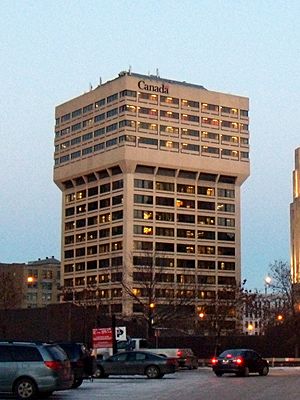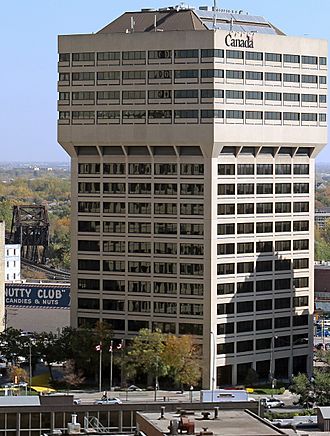Canadian Grain Commission facts for kids
| Commission canadienne des grains | |
 CGC building at 303 Main Street in Winnipeg |
|
| Agency overview | |
|---|---|
| Formed | 1912 |
| Preceding agency |
|
| Headquarters | 303 Main St., Winnipeg, Manitoba |
| Minister responsible |
|
| Agency executives |
|
| Key document |
|
| Website | https://grainscanada.gc.ca |
The Canadian Grain Commission (CGC) is a special agency of the Canadian government. Its main job is to make sure that Canada's grain industry works well. This includes checking the quality of grain and protecting the rights of farmers. The CGC helps ensure that grain sold in Canada and to other countries is always of good quality.
Contents
What the Canadian Grain Commission Does
The Canadian Grain Commission helps manage the grain industry in Canada. The Minister of Agriculture and Agri-Food is in charge of overseeing the CGC. The rules for the CGC come from a law called the Canada Grain Act. This law explains how the commission should work.
The CGC has three main leaders, called commissioners. One of them is the chief commissioner. The main office for the CGC is in Winnipeg, Manitoba. They also have offices in Montreal and Vancouver. These offices help with checking grain, weighing it, and doing tests.
The CGC's important jobs include:
- Making sure Canadian grain always meets high quality standards.
- Controlling how grain is handled in Canada. This helps make sure grain is reliable for both Canadian use and for selling to other countries.
- Creating and keeping up with grain grades and standards. This system helps show the quality of Canadian grain. It also makes it easier to sell grain in Canada and around the world.
A Look Back: History of the CGC
The Canadian Grain Commission started in 1971. Before that, it was known as the Board of Grain Commissioners for Canada. This board was first created in 1912. Even back then, people often called it the "Canadian grain commission."
The original law from 1912 said that all owners of grain elevators, warehouses, and mills needed a special license. It also made sure that grain was handled and stored properly. This law even stopped people who owned terminal elevators from buying or selling grain themselves. It also set up rules for inspecting and grading grain.
Over the years, there were some important legal decisions about the CGC's powers. For example, courts decided how much power the federal government had over grain businesses. These decisions helped shape how the CGC works today. They made sure the government could set rules for grain handling across Canada.
The CGC Building
| Canadian Grain Commission Building | |
|---|---|

Grain Commission building, No. 1 Northern visible in the forecourt
|
|
| General information | |
| Architectural style | Modernist |
| Location | Winnipeg, Manitoba |
| Opened | 1972 |
| Owner | Government of Canada |
| Design and construction | |
| Architect | Ernest J. Smith |
The Canadian Grain Commission's main building is in Winnipeg. It opened in 1972.
Building Design
The building was designed by Ernest J. Smith. It is sometimes called the "mushroom building" because of its unique shape. It is a good example of Modernist style. The building has a large "cap" at the top. This design was needed to make space for special machines. These machines help move grain to a flour mill and a test brewery located on the upper floors.
Sculpture Outside the Building
In 1976, a large steel sculpture was placed in front of the building. It was called No. 1 Northern. The artist, John Cullen Nugent, wanted it to look like fields of wheat. It was painted bright yellow, like harvest wheat. The sculpture was meant to represent Canada's top-grade red spring wheat.
However, many people, including some officials and the public, did not like the sculpture. It was removed in 1978. Later, in 1997, the sculpture was put back in front of the Grain Commission building.
Images for kids
See also
 In Spanish: Canadian Grain Commission para niños
In Spanish: Canadian Grain Commission para niños



